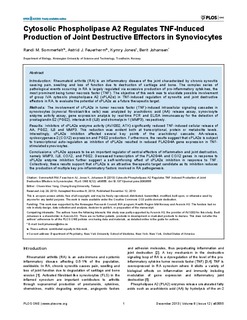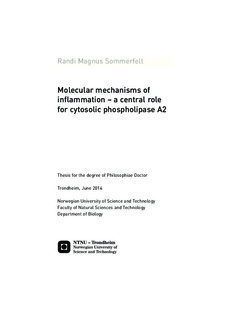| dc.contributor.author | Sommerfelt, Randi Magnus | nb_NO |
| dc.date.accessioned | 2014-12-19T13:13:52Z | |
| dc.date.available | 2014-12-19T13:13:52Z | |
| dc.date.created | 2014-07-28 | nb_NO |
| dc.date.issued | 2014 | nb_NO |
| dc.identifier | 735428 | nb_NO |
| dc.identifier.isbn | 978-82-326-0300-8 (printed ver.) | nb_NO |
| dc.identifier.isbn | 978-82-326-0301-5 (electronic ver.) | nb_NO |
| dc.identifier.uri | http://hdl.handle.net/11250/245534 | |
| dc.description.abstract | cPLA2α – a central regulator of inflammation
Bioactive lipids are central in regulating the inflammatory process and imbalance in lipid mediator signaling contributes to progression of pathological conditions such as atherosclerosis, allergy, autoimmunity, degenerative diseases and cancer. Phospholipase A2 (PLA2) enzymes release fatty acids such as arachidonic acid (AA) and a lysophospholipid from cellular membranes. Lysophospholipids can me metabolized to biologically active lipid mediators including platelet-activating factor (PAF). PAF is a potent mediator of inflammation, but can also exert a range of other physiological and pathophysiological processes including apoptosis, proliferation and cancer development. AA is a precursor of many bioactive lipid including prostaglandins such as prostaglandin E2 (PGE2), a potent immunoregulator and inducer of inflammation, fever and pain.
In particular cytosolic phosholipase A2 (cPLA2α) is associated with inflammation and inflammatory disease as a main enzyme mediating AA release and proinflammatory eicosanoid production, and is proposed as a future therapeutic target. However, lipid signaling is complex and sophisticatedly regulated, and the downstream consequences of cPLA2α inhibition are not fully understood. The overall objective of this thesis was to investigate the role of PLA2 enzymes, in particular cPLA2α, and downstream lipid messengers in cellular signaling mechanisms involved in chronic inflammatory disease. In Paper I, we investigated the role of PAF in differentiated keratinocytes, a cellular model system for psoriatic skin. We found that PAF did not primarily induce pro-inflammatory signaling, but rather proliferative responses possibly linking the inflammatory response to re-epithelialization and wound-healing. In the second part of this thesis comprising Papers II-IV, we focused on the role of cPLA2α in regulating pro-inflammatory signaling pathways central in the pathogenesis of rheumatoid arthritis (RA). In Paper II, we found cPLA2α to regulate joint-destructive and pro-inflammatory effectors induced by tumor necrosis factor (TNF), a “master” cytokine in RA. In Papers III and IV, we investigated the role of cPLA2α in modulating TLR-induced signaling. TLRs constitute a central part in the innate immune system sensing invading pathogens and tissue injury. However, TLRs can also induce “sterile” inflammation by recognizing molecules derived from the host itself, and increased TLR activation is believed to contribute to the pathogenesis of a range of inflammatory and autoimmune diseases including RA. We found that cPLA2α regulates TLR-induced activation of the transcription factor NF-κB and expression of several pro-inflammatory mediators. We furthermore identified PGE2 and possibly other related prostanoids as actors in this mechanism.
Taken together, our findings expand the understanding of cPLA2α as a central regulator of molecular mechanisms in chronic inflammation, and enlighten the potential role of cPLA2α and PAF in linking the inflammatory and proliferatory processes | nb_NO |
| dc.description.abstract | cPLA2α - en sentral regulator i kronisk inflammasjon
Lipider spiller en viktig rolle som signalmolekyler i inflammatoriske sykdommer som aterosklerose (hjerte- og karsykdom), revmatoid artritt, psoriasis, multiple sklerose og også i kreft. I dette forskningsprosjektet har vi undersøkt rollen til et enzym, cPLA2α og ulike lipider i molekylære mekanismer i kronisk inflammasjon, med tanke på utvikling av framtidige medisiner mot kronisk inflammatoriske sykdommer.
PLA2-enzymer klipper løs fettsyrer fra fosfolipider i cellemembranen, og regulerer dermed produksjonen av en rekke ulike bioaktive lipider som platelet-activating factor (PAF) og prostaglandin E2 (PGE2). Både PAF og PGE2 er kjent som potente pro-inflammatoriske signalmolekyler, med de er også involvert i en rekke andre prosesser.
I Del I av prosjektet undersøkte vi rollen til PAF i hudceller, som modellsystem for psoriasis. Vi fant at PAF primært induserte proliferasjon og migrasjon, og ikke inflammasjon. Dette kan bety at PAF i hud produseres som et signal som forbinder den inflammatoriske prosessen og sårheling, og kan potensielt også være involvert i patologisk hyperproliferasjon, som hudkreft.
I Del II undersøkte vi hvordan cPLA2α regulerer inflammatorisk signalisering i leddhinneceller, som et modellsystem for revmatoid artritt. Vi fant at cPLA2α regulerer genuttrykk og produksjon proteiner og lipider relatert til inflammasjon, dannelsen av nye blodårer og ledd-destruksjon. Ved å hemme cPLA2α ble disse faktorene redusert, noe som kan være gunstig med tanke på sykdomshemmende effekt.
Sett i sammenheng viser våre resultater at cPLA2α og lipider dannet nedstrøms dens aktivitet regulerer viktige prosesser i kronisk inflammasjon, prosesser som også er relatert til kreft. Molekyler som hemmer cPLA2α eller PAF-signalisering kan dermed representere nye medisiner mot kronisk inflammatoriske sykdommer som revmatoid artritt og psoriasis, og potensielt også kreft. | nb_NO |
| dc.language | eng | nb_NO |
| dc.publisher | Norges teknisk-naturvitenskapelige universitet, Fakultet for naturvitenskap og teknologi, Institutt for biologi | nb_NO |
| dc.relation.ispartofseries | Doktoravhandlinger ved NTNU, 1503-8181; 2014:189 | nb_NO |
| dc.relation.haspart | Feuerherm, Astrid Jullumstrø; Jørgensen, Katarina Mariann; Sommerfelt, Randi Magnus; Eidem, Live Egeland; Lægreid, Astrid; Johansen, Berit. Platelet-activating factor induces proliferation in differentiated keratinocytes. Molecular and Cellular Biochemistry. (ISSN 0300-8177). 384(1-2): 83-94, 2013. <a href='http://dx.doi.org/10.1007/s11010-013-1784-6'>10.1007/s11010-013-1784-6</a>. | nb_NO |
| dc.relation.haspart | Sommerfelt, Randi Magnus; Feuerherm, Astrid Jullumstrø; Jones, Kymry; Johansen, Berit. Cytosolic phospholipase A2 regulates TNF-induced production of joint destructive effectors in synoviocytes. PLoS ONE. (ISSN 1932-6203). 8(12), 2013. <a href='http://dx.doi.org/10.1371/journal.pone.0083555'>10.1371/journal.pone.0083555</a>. | nb_NO |
| dc.relation.haspart | Sommerfelt, Randi Magnus; Feuerherm, Astrid Jullumstrø; Skuland, Trine; Johansen, Berit. Cytosolic phospholipase A2 modulates TLR2 signaling in synoviocytes.. , 2014. | nb_NO |
| dc.relation.haspart | Sommerfelt, Randi Magnus; Feuerherm, Astrid Jullumstrø; Nguyen, Thank Thuy Thi; Johansen, Berit. cPLA2α regulates TLR2/6-induced NF-κB activation and IL-6 production through COX/PGE2 in humansynoviocytes.. , 2014. | nb_NO |
| dc.title | Molecular mechanisms of inflammation – a central role for cytosolic phospholipase A2 | nb_NO |
| dc.type | Doctoral thesis | nb_NO |
| dc.contributor.department | Norges teknisk-naturvitenskapelige universitet, Fakultet for naturvitenskap og teknologi, Institutt for biologi | nb_NO |
| dc.description.degree | PhD i biologi | nb_NO |
| dc.description.degree | PhD in Biology | en_GB |


